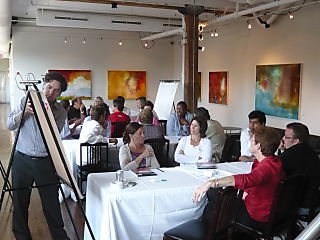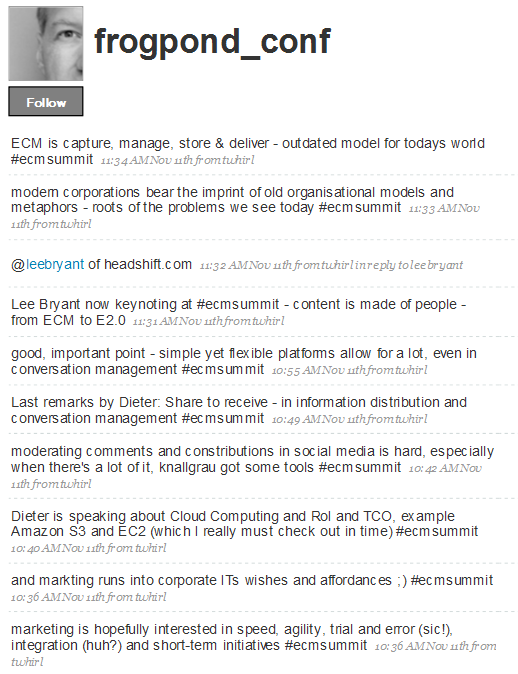 Via Oliver Marks I found an article (free download at nGenera) who appeared in the November issue of Harvard Business Review (“Teaming Up to Crack Innovation and Enterprise Integration”) by Robert Morison of nGenera (yes, Don Tapscott is involved …), James Cash and Michael Earl of Oxford and Harvard respectively.
Via Oliver Marks I found an article (free download at nGenera) who appeared in the November issue of Harvard Business Review (“Teaming Up to Crack Innovation and Enterprise Integration”) by Robert Morison of nGenera (yes, Don Tapscott is involved …), James Cash and Michael Earl of Oxford and Harvard respectively.
Picture to the left by Idris Motee who understands the need for interdisciplinary creative thinkers
Morison et al.s “idea in brief”:
Your company is continuously creating new generations of products, services, and business processes. These innovations require seamless collaboration across your firm’s different parts. But in most large corporations, innovation and integration are unnatural acts. Resistance stifles new ideas, and silos block cross-functional cooperation.
[…] explore how some companies are overcoming these boundaries […] establishing two new types of cross-organizational teams:
– Distributed innovation groups (DIGs) – foster innovation throughout the company.
For example, they deploy intranet based forums and wikis to scout for promising ideas.
– Enterprise integration groups (EIGs) – establish the architecture and management practices essential for business integration. For instance, they identify
integration opportunities, channel resources to them, and reconfigure Enterprise Resource Planning (ERP) systems to support ever-tighter crossbusiness collaboration.
To establish each of these groups, select a small number of talented people who combine broad business knowledge, technology expertise, and the social skills needed to build relationships both within and outside your company.
Yes, establishing tools and protocols is only the start. People and their skills (that includes leadership, being trustworthy and good at team building) are essential, especially when dealing with innovative tasks. And it’s more challenging when dealing with scattered (or even rivaling) business units.
So I liked the sound strategic thinking Oliver added – namely what separates the successful collaborative enterprise from those that aren’t – even more as he pointed out usage arenas like business intelligence, internal and external environmental scanning. These are memes worth expanding upon: one of the often overlooked benefits of Enterprise Social Software like wikis is that it both puts real time information to the front-lines of a corporation and collects the wisdom that is spread at the “edges” of the company:
[…] DIG’s could include, as examples, scouting for new ideas and untapped potential in current technologies, scanning the external environment for emerging technologies, Facilitating participation in idea forums, acting as an innovation expertise center, serving as an incubator for promising innovations and publicizing promising innovations and funds.
and
[…] why there are so many sparsely populated wikis and blogs slowly twisting in the wind in the corporate world – because they were set up as tentative trial balloons with no clear utility or guidelines for expected use. It’s trivial to set up a blog or a wiki from a technical perspective – you could do it in the time it took to read this article – setting up the internal use case to ’scout for promising ideas’, for example, takes a great deal more thought and planning.
The real challenge is in finding the key people […] these are the core resources that will drive innovation, adoption of associated methodologies and their enabling technologies and the successful execution of usage models.
People issues again, but it also reminded me of this (old) article by Rob Cross, Andrew Hargadon et al. (“Together We Innovate“) on the MIT Sloan Management website (and it isn’t about scouting for ideas inside the organization alone, right). It claims “How can companies come up with new ideas? By getting employees working with one another”,
[…] problems that stifle innovation. They share a couple of common themes: the failure to effectively leverage the expertise of employees (or their peers in partner organizations) and the failure to react effectively when new ideas do arise. But we’ve also found five steps companies can take to clear those barriers and start producing big ideas.
Cross, Hargadon et al. collect some network problems (and wrangle some ideas on how to solve them too):
1. No Communication […] the structure of the company keeps people apart […]
2. Bad Gatekeepers […]
3. Insularity […]
Check out the proposed “solution takes” – and see that these are about people and leadership in the beginning but include as well adaptivity & agility, connectivity and emergence (well, they don’t name it but it’s shinig all through, like when arguing that we need systems that allow for easy collaboration, in my book that means systems that can be personalized and tweaked to my very own needs).


